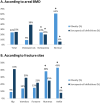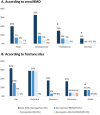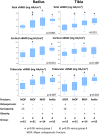Are low-trauma fractures all fragility fractures? Insights into musculoskeletal and body composition characteristics of community-dwelling post-menopausal women with a recent fracture
- PMID: 40802028
- PMCID: PMC12350515
- DOI: 10.1007/s40520-025-03154-w
Are low-trauma fractures all fragility fractures? Insights into musculoskeletal and body composition characteristics of community-dwelling post-menopausal women with a recent fracture
Abstract
Background and aims: The incidence of fragility fractures is increasing among community-dwelling postmenopausal women. Sarcopenia and obesity are significant risk factors for fractures, independent of osteoporosis. This study aims to investigate the prevalence of sarcopenia and obesity, as well as bone microstructure, according to osteoporotic status and fracture sites in older women with recent low-trauma fractures.
Methods: This cross-sectional study included 135 community-dwelling postmenopausal women aged 65 and older, evaluated within six months of experiencing a low-trauma fracture (resulting from a fall from standing height or less) occurring at the humerus, proximal femur, vertebrae, pelvis, forearm, or ankle. Participants were recruited either prospectively through the Fracture Liaison Service (FLS) at the Bone Disease Department of Geneva University Hospitals (HUG) (n = 90) or retrospectively from the Geneva Retirees Cohort (GERICO) (n = 45). Bone mineral density (BMD) and body composition were assessed using dual-energy X-ray absorptiometry (DXA), muscle strength was measured by handgrip strength (HGS), and bone microstructure was evaluated using high-resolution peripheral quantitative computed tomography (HR-pQCT).
Results and discussion: The prevalence of sarcopenia varied, with the overall prevalence across all definitions being 25%. It was significantly higher in osteoporotic women than in women with normal BMD (39% versus 6%, respectively, p = 0.014) and osteopenia (39% versus 20% respectively, p < 0.05). The prevalence of obesity was 24%, with particularly high rates observed among women with normal BMD (61%) and those with ankle or humerus fractures (43%, and 38%, respectively). Notably, 33% of women with major osteoporotic fractures (MOF) presented with normal BMD and without sarcopenia or obesity.
Conclusions: A significant proportion of women with apparent low-trauma MOF does not have osteoporosis nor alterations of body composition (sarcopenia or obesity). The determinants of fracture risk in these women remain unclear and further investigations are required to better address secondary fracture prevention in this context.
Supplementary Information: The online version contains supplementary material available at 10.1007/s40520-025-03154-w.
Keywords: Bone microstructure; Fragility fracture; Obesity; Osteoporosis; Sarcopenia.
Conflict of interest statement
Declarations. Competing interests: The authors declare no competing interests.
Figures



Similar articles
-
Fragility Fracture: 10 Commandments.Indian J Orthop. 2025 Mar 27;59(3):244-255. doi: 10.1007/s43465-025-01356-y. eCollection 2025 Mar. Indian J Orthop. 2025. PMID: 40201916
-
Patella fractures are associated with bone fragility - a retrospective study.J Bone Miner Res. 2024 Nov 29;39(12):1752-1761. doi: 10.1093/jbmr/zjae165. J Bone Miner Res. 2024. PMID: 39385460
-
Geriatric nutritional risk index as a predictor for fragility fracture risk in elderly with type 2 diabetes mellitus: A 9-year ambispective longitudinal cohort study.Clin Nutr. 2024 May;43(5):1125-1135. doi: 10.1016/j.clnu.2024.03.032. Epub 2024 Apr 1. Clin Nutr. 2024. PMID: 38583354
-
Vitamin D and vitamin D analogues for preventing fractures associated with involutional and post-menopausal osteoporosis.Cochrane Database Syst Rev. 2001;(1):CD000227. doi: 10.1002/14651858.CD000227. Cochrane Database Syst Rev. 2001. Update in: Cochrane Database Syst Rev. 2005 Jul 20;(3):CD000227. doi: 10.1002/14651858.CD000227.pub2. PMID: 11279685 Updated.
-
A systematic review of the effectiveness of strategies for reducing fracture risk in children with juvenile idiopathic arthritis with additional data on long-term risk of fracture and cost of disease management.Health Technol Assess. 2008 Mar;12(3):iii-ix, xi-xiv, 1-208. doi: 10.3310/hta12030. Health Technol Assess. 2008. PMID: 18284894
References
-
- Odén A, McCloskey EV, Kanis JA, Harvey NC, Johansson H (2015) Burden of high fracture probability worldwide: secular increases 2010–2040. Osteoporos Int 26(9):2243–2248 - PubMed
LinkOut - more resources
Full Text Sources

